I am writing a raycaster using SDL's C API. I have spent weeks trying to fix the notorious fisheye effect to no avail. According to this source, I can multiply my calculated distance by the cosine of half of the FOV to fix it. That has not worked for me. I still have the cosine correction in my code nonetheless.
Here are two images demonstrating the distortion:


I think a core problem of my code may be that my angle increment is constant, while the increment should be smaller as I'm closer to the screen borders. Unfortunately, I don't know how to start implementing this.
If possible, could anyone please take a look at my code and give me a tip on how to remove the fisheye? To move in any direction, use the arrow keys. Use the 'a' and 's' keys to turn left and right respectively.
This is how I'm compiling: clang `pkg-config --cflags --libs sdl2` raycaster.c
#include <SDL2/SDL.h>
#include <math.h>
typedef struct {
float x, y, prev_x, prev_y, angle, fov;
} Player;
enum {
map_width = 12, map_height = 15,
screen_width = 800, screen_height = 500
};
const float
move_speed_decr = 0.08,
angle_turn = 2.0,
ray_theta_step = 0.4,
ray_dist_step = 0.8,
darkening = 1.8,
width_ratio = (float) screen_width / map_width,
height_ratio = (float) screen_height / map_height;
const unsigned char map[map_height][map_width] = {
{1, 1, 1, 1, 1, 1, 1, 1, 1, 1, 1, 1},
{1, 0, 0, 0, 0, 0, 0, 0, 0, 0, 0, 1},
{1, 0, 0, 0, 0, 0, 0, 0, 0, 0, 0, 1},
{1, 0, 0, 0, 0, 0, 0, 0, 1, 1, 1, 1},
{1, 0, 4, 3, 2, 0, 0, 0, 2, 0, 0, 1},
{1, 0, 0, 0, 1, 0, 0, 0, 3, 0, 0, 1},
{1, 0, 0, 0, 4, 3, 2, 1, 4, 0, 0, 1},
{1, 0, 0, 0, 0, 0, 0, 0, 0, 0, 0, 1},
{1, 0, 0, 0, 0, 0, 0, 0, 0, 0, 0, 1},
{1, 0, 0, 0, 0, 0, 0, 0, 0, 0, 0, 1},
{1, 0, 0, 0, 0, 0, 0, 0, 0, 0, 0, 1},
{1, 0, 0, 0, 0, 0, 0, 0, 0, 0, 0, 1},
{1, 0, 0, 0, 0, 0, 0, 0, 0, 0, 0, 1},
{1, 0, 0, 0, 0, 0, 0, 0, 0, 0, 0, 1},
{1, 1, 1, 1, 1, 1, 1, 1, 1, 1, 1, 1}
};
SDL_Window* window;
SDL_Renderer* renderer;
float to_radians(float degrees) {
return degrees * M_PI / 180;
}
float distance(float x0, float y0, float x1, float y1) {
return sqrt(((x1 - x0) * (x1 - x0)) + ((y1 - y0) * (y1 - y0)));
}
void shade(int* color, int darkener) {
int darkened = *color - darkener;
*color = darkened < 0 ? 0 : darkened;
}
void draw_rectangle(SDL_Rect rectangle, int r, int g, int b) {
SDL_SetRenderDrawColor(renderer, r, g, b, SDL_ALPHA_OPAQUE);
SDL_RenderFillRect(renderer, &rectangle);
SDL_RenderDrawRect(renderer, &rectangle);
}
void raycast(Player player) {
float relative_x = player.x * width_ratio;
float relative_y = player.y * height_ratio;
float half_fov = player.fov / 2;
float width_fov_ratio = (screen_width / player.fov) / 2;
float distort_adjust = cos(to_radians(half_fov));
// the core of my problem may be in the constant increment of my angle
for (float theta = player.angle - half_fov, screen_x = 0;
theta < player.angle + half_fov;
theta += ray_theta_step, screen_x += width_fov_ratio) {
float radian_theta = to_radians(theta);
float cos_theta = cos(radian_theta), sin_theta = sin(radian_theta);
float d = 0, new_x, new_y;
while (d += ray_dist_step) {
new_x = cos_theta * d + relative_x;
new_y = sin_theta * d + relative_y;
int map_x = new_x / width_ratio, map_y = new_y / height_ratio;
int map_point = map[map_y][map_x];
if (map_point) {
int dist_wall = distance(relative_x, relative_y, new_x, new_y) * distort_adjust;
int twice_dist_wall = 2 * dist_wall;
if (twice_dist_wall >= screen_height) break;
else if (map_point) { // succeeds when a wall is present
int r, g, b;
switch (map_point) {
case 1: r = 255, g = 255, b = 0; break;
case 2: r = 0, g = 128, b = 128; break;
case 3: r = 255, g = 165, b = 0; break;
case 4: r = 255, g = 0, b = 0; break;
}
int color_decr = dist_wall / darkening;
shade(&r, color_decr);
shade(&g, color_decr);
shade(&b, color_decr);
SDL_Rect vertical_line = {
screen_x, dist_wall,
width_fov_ratio + 1,
screen_height - twice_dist_wall
};
draw_rectangle(vertical_line, r, g, b);
break;
}
}
}
}
}
void handle_input(const Uint8* keys, Player* player) {
SDL_Event event;
while (SDL_PollEvent(&event)) {
if (event.type == SDL_QUIT) {
SDL_DestroyWindow(window);
SDL_DestroyRenderer(renderer);
exit(0);
}
else if (event.type == SDL_KEYDOWN) {
float radian_theta = to_radians(player -> angle);
float move_x = cos(radian_theta) * move_speed_decr,
move_y = sin(radian_theta) * move_speed_decr;
// handle arrow keys
if (keys[SDL_SCANCODE_UP]) player -> x += move_x, player -> y += move_y;
if (keys[SDL_SCANCODE_DOWN]) player -> x -= move_x, player -> y -= move_y;
if (keys[SDL_SCANCODE_LEFT]) player -> x += move_y, player -> y -= move_x;
if (keys[SDL_SCANCODE_RIGHT]) player -> x -= move_y, player -> y += move_x;
// handle 'a' and 's' for angle changes
if (keys[SDL_SCANCODE_A]) player -> angle -= angle_turn;
if (keys[SDL_SCANCODE_S]) player -> angle += angle_turn;
// safeguards for invalid positions and angles
if (player -> x < 0) player -> x = 0;
else if (player -> x > screen_width) player -> x = screen_width;
if (player -> y < 0) player -> y = 0;
else if (player -> y > screen_height) player -> y = screen_height;
// move the player to their previous coordinate if they're in a wall
if (map[(int) player -> y][(int) player -> x])
player -> y = player -> prev_y, player -> x = player -> prev_x;
if (player -> angle > 360) player -> angle = 0;
else if (player -> angle < 0) player -> angle = 360;
player -> prev_y = player -> y, player -> prev_x = player -> x;
}
}
}
int main() {
SDL_CreateWindowAndRenderer(screen_width, screen_height, 0, &window, &renderer);
SDL_SetWindowTitle(window, "Raycaster");
Player player = {5, 5, 0, 0, 0, 60};
SDL_Rect the_ceiling = {0, 0, screen_width, screen_height / 2};
SDL_Rect the_floor = {0, screen_height / 2, screen_width, screen_height};
const Uint8* keys = SDL_GetKeyboardState(NULL);
while (1) {
handle_input(keys, &player);
draw_rectangle(the_ceiling, 96, 96, 96);
draw_rectangle(the_floor, 210, 180, 140);
raycast(player);
SDL_RenderPresent(renderer);
SDL_UpdateWindowSurface(window);
}
}
After help from RandomDavis, the distortion is lessened. Here is the new result. Nonetheless, some warping remains:



NOTE: To anyone who is still struggling with this problem, I solved it here: How do I fix warped walls in my raycaster?

